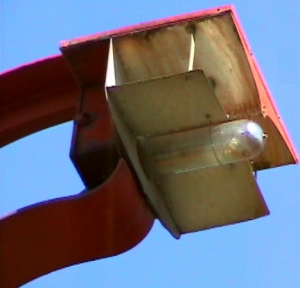Part Three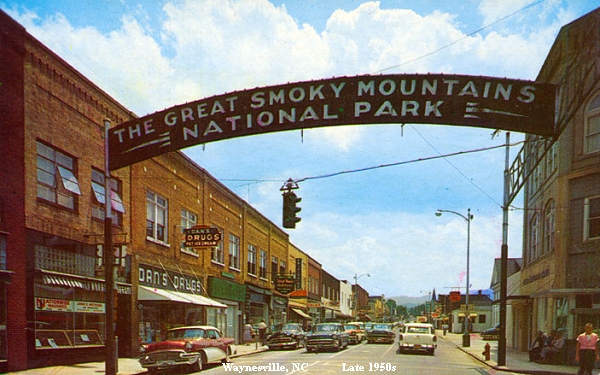
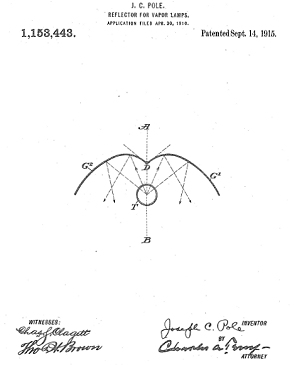
Experiments were conducted using various gasses such as mercury vapor as far back as the early 1900s. These lamps were intended as improvements on the old carbon arc lamps. With a mercury vapor lamp an arc could be sustained nearly indefinitely through the vapor. A relatively brilliant light could be produced with very little deterioration of the electrodes. Early mercury vapor lamps had some undesirable characteristics, however. They were difficult to light in cold weather. They produced an unpleasant blue-green color that made rendering of colors difficult in the areas that they lit. They required significantly more start-up current than operating current. As a result the numbers of lamps in series strings had to be less than the capacity of regulators supplying them in order to receive enough start-up power when the lamps were first turned on. Furthermore, mercury vapor lamps had a phenomenon that they would actually absorb reflected light, so luminaire reflectors had to be designed to direct as much light away from the lamp itself as possible. Nonetheless, mercury vapor lamps produced a great deal of usable light for the power consumed, far greater than incandescent lamps, so there was a great deal of interest in advancing mercury vapor technology.
In the 1920s and 30s a great deal of experimentation was conducted with inert gasses that produced light when ionized. Illuminated letters could be formed by bending tubes filled with neon gas. Mercury vapor produced ultra violet light that caused various phosphors to glow, most commonly for fluorescent lighting in stores and offices. In the 1930s GE experimented with mercury vapor lighting in business districts in Brooklyn. Eventually the design was perfected so that the lamps gave off a great deal of fairly white light and they became suitable for street lighting. Mercury vapor lamps required electrical ballasts to regulate individual lamp current. In series circuits The lamp ballasts also served as shunts that preserved continuity when mercury vapor lamps failed. Although mercury vapor lamps were more efficient than incandescent lamps, providing more lumens of light per watt consumed, for many years they were relegated to business and industrial districts due to the poor color rendition value of mercury light as compared with incandescent illumination.
The first mercury vapor lamp designs utilized remote ballasts that were mounted on poles or in compartments located at the bottom of metal masts. Eventually the ballasts were integrated into the luminaire, most commonly in the "cobra head" and NEMA (round) configurations. Some designers took the concept in a different direction creating luminaires that used high output fluorescent lamps. Mercury vapor was still the source of light, but fluorescent tubes could provide improved color rendition. Fluorescent "White Way" installations could provide high quality, low glare and uniform light. Unfortunately fluorescent lamps did not perform well in extreme temperatures, providing weak light or occasionally failing to light altogether when they became too cold. Ballasts would occasionally overheat and fail during extreme high temperatures.
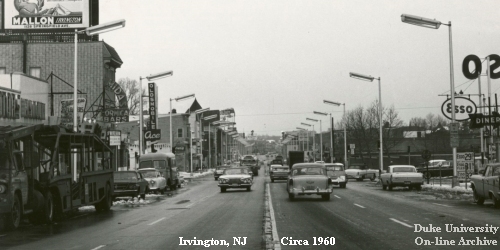
In residential neighborhoods incandescent lamps were still "king." However as energy costs rose, most incandescent residential luminaires were changed out for mercury vapor, either by switching out the luminaires completely or by installing remote ballasts and exchanging incandescent lamp bulbs for mercury vapor lamp bulbs in those existing luminaires that could accommodate them. |
This luminaire, GE's Form M2, was installed on several important highways and bridges. M2s served the Golden Gate Bridge from 1937 until 1972 when they were replaced with high pressure sodium fixtures having special amber lenses. A GE M2 Luminaire on the Golden Gate Bridge
|
If you have comments, see an error or think of something that should be added to this section, please
Email me.
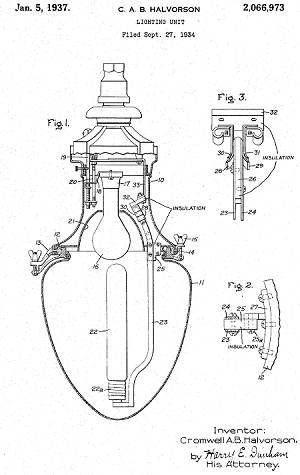 To deal with the awkward color produced and cold starting issues, many early mercury vapor lamps were produced in combination with incandescent lamps. These combination designs reduced the efficiency of the mercury vapor lamps (requiring additional power to light the incandescent lamps) however they did produce extremely powerful lamps for their time.
To deal with the awkward color produced and cold starting issues, many early mercury vapor lamps were produced in combination with incandescent lamps. These combination designs reduced the efficiency of the mercury vapor lamps (requiring additional power to light the incandescent lamps) however they did produce extremely powerful lamps for their time.
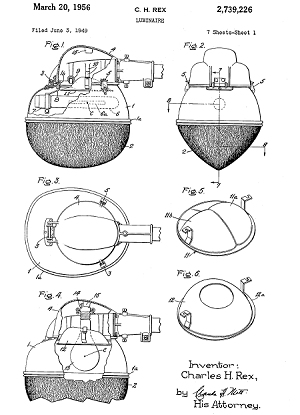 On June 3, 1949, GE applied for a patent for a luminaire designed by Charles Rex. It was a 400 watt mercury vapor lamp that had very efficient optics known as the Form 109. This luminaire was a game changer and many cities then adopted mercury vapor lighting in downtown districts and on large boulevards.
On June 3, 1949, GE applied for a patent for a luminaire designed by Charles Rex. It was a 400 watt mercury vapor lamp that had very efficient optics known as the Form 109. This luminaire was a game changer and many cities then adopted mercury vapor lighting in downtown districts and on large boulevards.
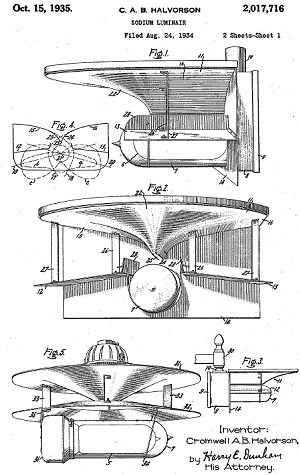 On August 24, 1934, GE filed for a patent on a low pressure sodium luminaire that Cromwell Halvorsen designed. His design produced a great amount of usable light and consumed only 90 watts of power. The color was yellow-amber but the amount of light produced per watt was incredible for its day.
On August 24, 1934, GE filed for a patent on a low pressure sodium luminaire that Cromwell Halvorsen designed. His design produced a great amount of usable light and consumed only 90 watts of power. The color was yellow-amber but the amount of light produced per watt was incredible for its day.
